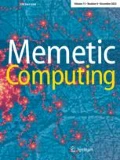The past 10 years of Memetic Computing has been a memorable and exciting journey. Managing a journal starting from an infancy stage and growing it to its current reputable standing has been challenging and exciting. Clearly, this journal with its own unique features has also established an identity from a technical viewpoint, particularly on algorithms innovations for computational problem-solving. I am proud to present a compilation of seven papers covering diverse topics related to Memetic Computing selected for this issue. I am much inclined to call it the beginning of the next 10-year phase of this journal.
The first paper selected for this issue is by Liang et al. which touches on evolution of meme space. In particular, they address the issue of data intensity characteristic of optimization problems in the era of rapid growth in communication and computing technologies. To effectively deal with the so-called big problems in the current context, it is inevitable that learning is incorporated in optimization algorithms to deal with the complexity. They propose a compressed representation with high-level meme evolution, which deviates from conventional optimization at the solution space level. The high-level meme space evolution involved meme which represents block of knowledge or instruction for solving the knapsack problem. The search in meme space provides a compressed form of optimization. Empirical results involving large scale problems of up to 10,000 items were used to demonstrate the potential of this framework for big optimization.
Two papers on extreme learning machine (ELM) have been selected as part of this issue. The first by Cao et al. improves on the incremental learning of bidirectional ELM (B-ELM). In particular, they proposed an enhanced B-ELM to more effectively manage the addition of hidden nodes. Results from simulations show better performance in terms of convergence speed and compactness. The other paper on ELM is by Lu et al. with the proposal of an improved weighted ELM for imbalanced data classification. They incorporated a voting scheme to eliminate classes that are not useful. Through simulations on real-world imbalanced datasets, they validated the improvement in performance over normal weighted ELM.
Local search is an important feature of memetic search techniques. The work by Bereta explores two local search procedures which are studied analytically for its effectiveness through rigorous statistical procedures. Specifically, the author considered two procedures, the correction procedure to repair the solution according to the degree and angle conditions followed by the improvement procedure which involved actively adding new points. The Euclidean Steiner tree problem was used as a case study and further validations on standard benchmarks test set were used to substantiate their work.
The paper by Cai et al. deals with extraction of foreground region in image matting. The common approach for extraction involves sampling of foreground and background pixels. The issue of finding the best sampling pair to get a good and reliable estimate of the background and foreground can be formulated as a combinational optimization problem. In this work, they experimented with a relatively new nature-inspired earthworm optimization algorithm with modifications of the reproduction operations and cauchy mutation. Their results on image matting for standard benchmark dataset were reported to be more accurate based on visual and quantitative metric.
In previous issue, we ran a thematic on brain storm optimization (BSO), a novel evolutionary algorithm inspired by the way humans carry out brainstorming process. In the paper by Wang and co-workers, theoretical analysis on performance based on population evolution and population interaction network (PIN) is used to construct relationship among individuals in BSO. They investigate the effect of parameters of BSO, studying the effect of population interaction according to the power law distribution on algorithm performance. In addition, the mutual effect among parameters is analyzed to derive optimal setting in order to significantly enhance the performance of BSO. The results of their work show that a power law distribution is more effective for boosting the population interaction thereby enhancing performance of algorithms.
The final paper of this issue by Xu et al. considers the dual objective coverage problem for wireless sensor networks using a time-efficient differential evolution approach. They introduced a time-efficient non-dominated sorting of solutions which focuses on the highest ranked individuals coupled with the incorporation of uniform crowding distance to enhance diversity. Through their fast two-objective framework, the algorithm optimizes based on the minimization of number of sensors and maximizing coverage. They showed competitive simulation results in terms of time-complexity and performance.
A compilation of seven papers for the first issue of 2019 serves as a good starting point for the next 10 years of this journal. I am very excited about the year ahead as I see tremendous push towards innovative approaches by workers in the field, recognizing that the era of computational problem-solving is also evolving accordingly. The seamless world-wide connectivity nowadays brings along new challenges while at the same time, brings along exciting opportunities in terms of technical innovations from the viewpoint of algorithms development. As always, I am always grateful to the team of editors and reviewers. Their hard work and dedication in evaluating the manuscripts has been instrumental in maintaining the quality and standing of this journal as a reputable publication platform.
Author information
Authors and Affiliations
Corresponding author
Additional information
Publisher's Note
Springer Nature remains neutral with regard to jurisdictional claims in published maps and institutional affiliations.
Rights and permissions
About this article
Cite this article
Lim, MH. Editorial. Memetic Comp. 11, 1–2 (2019). https://doi.org/10.1007/s12293-019-00281-6
Published:
Issue Date:
DOI: https://doi.org/10.1007/s12293-019-00281-6

